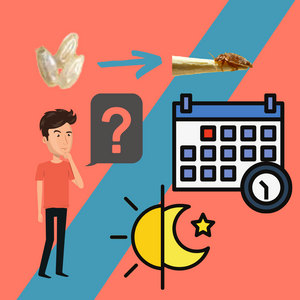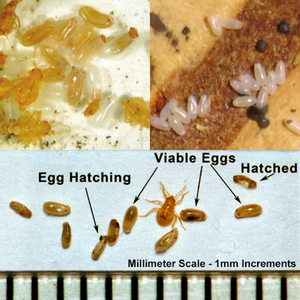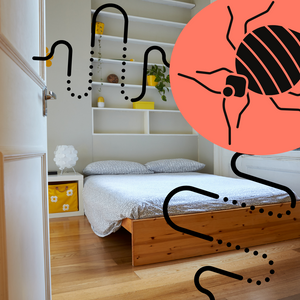Why Can’t You Feel Bed Bugs

Some people don’t react to bed bug bites. They may not even realize that there are bed bugs in their home until a large number of these critters have invaded their place. Bed bugs are light and small, so you may not even feel that they are crawling on you. It all depends on your body’s sensitivity and where the bed bugs are crawling.
Will You Feel Bed Bugs Crawling on Your Skin?
You can spot them without using a magnifying glass. These critters are extremely lightweight. Just think of an ant crawling on your skin, as it’s the same as the feeling of bed bugs crawling on you. The experience depends from one person to another. Whether or not you will feel bed bugs depends on various factors such as the following:
The sensitivity of your skin
People with sensitive skin experience stronger sensations than others. For instance, younger people are more likely to feel a light touch than older people.
Area of the body
Some areas of the body have higher sensitivity levels. For example, you have a higher chance of noticing bed bugs if they’re crawling through hairs like on your legs or arms. Your palms are also more sensitive compared to your back. This means that you’re more likely to feel bed bugs if they’re crawling on your palms.
Sleep vs awake
Bed bugs are particularly active at night because that’s when their victims lie still. If you’re asleep, you probably won’t feel anything. The sensation is extremely light that it’s likely not enough to wake you up.
You will not feel these critters crawling on you. Bed bugs are not social, so they will probably bite you when you’re sleeping deeply. Since bedbug bites have an anesthetic effect, you will not feel anything.
Those who have bed bug infestations at home constantly feel like there are bed bugs on them. You don’t need to worry because it is all in your mind.

Where Do Bed Bugs Hide?
Bed bugs can crawl on your skin without your knowledge, but they won’t live in your hair or on your body. These critters won’t hide in the clothes you’re wearing.
Bed bugs usually crawl into bags, pockets or shoes, so you could accidentally bring them home when you come back from your trip. However, they don’t live on their host.
When you go to another place, the bed bugs you brought by mistake will get off and look for a place to hide. They will most likely not feed on you while you’re moving about.
Bed bugs won’t allow their hosts to detect their presence. They will always hide, only coming out at night to feed on you. You won’t easily detect their action even when they are sucking your blood.
What’s worse is that you can’t sense bedbugs crawling nearby because you are asleep and these critters are wide awake. They are simply waiting for a chance to strike and feed on you.
How to Identify a Bed Bug Bite
You should know how to identify bed bug bites so that you can avoid bringing these tiny bloodsuckers home. This is particularly important if you’re staying in a hotel room and you think that there are bed bugs in the area.
It’s good if you don’t see bed bug bites on your body or family members. If you do, it’s a sign that you have a bed bug problem. These are the most common signs of bed bug bites.
Rash around the bite
The rash can make a cluster of bites from bed bugs look like hives instead of an insect bite. Not everyone develops a rash from bed bug bites immediately. For some people, it takes several bed bugs bites before they show allergic reactions.
Raised skin bumps
Bites from bed bugs can make the areas they have bitten rise into bumps. The bite often looks red, but that’s not always the case. Others are hypersensitive to bed bug bites and experience severe symptoms that need medical attention such as blisters, nausea, difficulty breathing, swollen tongue, fever and irregular heartbeat. Anti-itch creams, OTC hydrocortisone and antihistamines can be used to relieve itchy bites.
Clusters or rows of bites
Bed bugs feed several times at night, so their bites will appear in clusters or rows. Instead of having multiple single bites appearing on different areas of your body, the bites are grouped. Another sign of bed bug bites is clear or white skin shed by bed bugs nymphs.
These critters tend to bite your neck, shoulders, face, arms, hands, legs and other areas that are exposed when you’re asleep. Recognizing signs of bed bugs could save you from these bites and the problems they bring. Life is so much better without these pests.
Why You Should Use Mattress Covers
Mattress covers are designed to protect the top of your mattress. Ordinary mattress covers, however, can’t stop bed bugs from invading your mattress and box springs. Mattress encasements can reduce bed bug infestations because it prevents these critters from escaping once they enter your mattress.
Bed bugs will eventually die inside the tightly-woven fabric case. Critters left outside the mattress encasement can be easily spotted and removed. Bed bugs won’t find any cracks and crevices or creases where they can hide and breed. Moreover, they won’t be able to enter the mattress in the first place.






